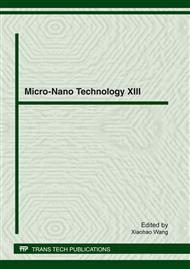p.303
p.308
p.312
p.318
p.324
p.329
p.334
p.341
p.348
Two Fabrication Schematics of Silicon Micro Perforated Panel Based on MEMS Technology
Abstract:
Two kinds of fabrication schematics of micro perforated panel (MPP) based on MEMS technology is expatiated in the article. MPP has been widely used to reduce noise, and theory reveals that better ability of sound absorption of the MPP will be getting by means of reducing the diameters and increasing the dense of the perforators properly. Small error of the dimension will decline the sound absorption seriously on such a scale. MEMS technology is applied to fabricate the micro perforated panel which is hard to be realized utilize machine. The parameters are calculated based on the theory of Maa D-Y to obtain a kind of wide band, high sound absorption structure. The computer simulation is also conducted to forecast the capability of the MPP and the experiment result shows the accordance with the simulations.
Info:
Periodical:
Pages:
324-328
Citation:
Online since:
February 2012
Authors:
Keywords:
Price:
Сopyright:
© 2012 Trans Tech Publications Ltd. All Rights Reserved
Share:
Citation:


